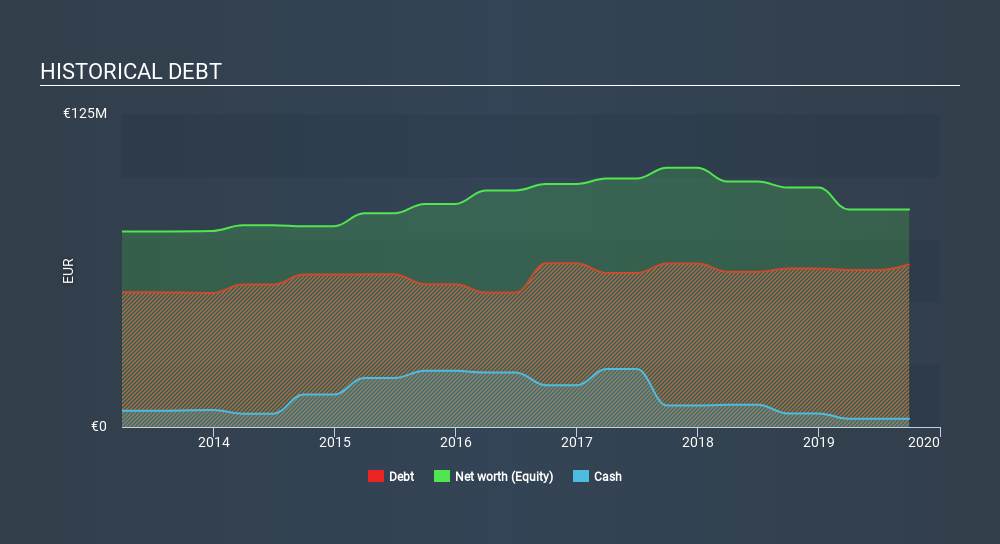
Howard Marks put it nicely when he said that, rather than worrying about share price volatility, 'The possibility of permanent loss is the risk I worry about... and every practical investor I know worries about. So it seems the smart money knows that debt - which is usually involved in bankruptcies - is a very important factor, when you assess how risky a company is. As with many other companies PCAS SA (EPA:PCA) makes use of debt. But should shareholders be worried about its use of debt?
Why Does Debt Bring Risk?
Debt is a tool to help businesses grow, but if a business is incapable of paying off its lenders, then it exists at their mercy. In the worst case scenario, a company can go bankrupt if it cannot pay its creditors. However, a more frequent (but still costly) occurrence is where a company must issue shares at bargain-basement prices, permanently diluting shareholders, just to shore up its balance sheet. Of course, plenty of companies use debt to fund growth, without any negative consequences. The first step when considering a company's debt levels is to consider its cash and debt together.
View our latest analysis for PCAS
What Is PCAS's Net Debt?
The chart below, which you can click on for greater detail, shows that PCAS had €62.7m in debt in June 2019; about the same as the year before. On the flip side, it has €3.31m in cash leading to net debt of about €59.4m.

How Strong Is PCAS's Balance Sheet?
Zooming in on the latest balance sheet data, we can see that PCAS had liabilities of €104.8m due within 12 months and liabilities of €73.8m due beyond that. On the other hand, it had cash of €3.31m and €68.7m worth of receivables due within a year. So its liabilities outweigh the sum of its cash and (near-term) receivables by €106.6m.
This deficit is considerable relative to its market capitalization of €145.7m, so it does suggest shareholders should keep an eye on PCAS's use of debt. This suggests shareholders would heavily diluted if the company needed to shore up its balance sheet in a hurry. There's no doubt that we learn most about debt from the balance sheet. But you can't view debt in total isolation; since PCAS will need earnings to service that debt. So when considering debt, it's definitely worth looking at the earnings trend. Click here for an interactive snapshot.
Over 12 months, PCAS made a loss at the EBIT level, and saw its revenue drop to €201m, which is a fall of 2.8%. That's not what we would hope to see.
Caveat Emptor
Importantly, PCAS had negative earnings before interest and tax (EBIT), over the last year. Indeed, it lost €4.9m at the EBIT level. When we look at that and recall the liabilities on its balance sheet, relative to cash, it seems unwise to us for the company to have any debt. Quite frankly we think the balance sheet is far from match-fit, although it could be improved with time. However, it doesn't help that it burned through €3.8m of cash over the last year. So suffice it to say we do consider the stock to be risky. The balance sheet is clearly the area to focus on when you are analysing debt. However, not all investment risk resides within the balance sheet - far from it. For example, we've discovered 3 warning signs for PCAS (1 makes us a bit uncomfortable!) that you should be aware of before investing here.
When all is said and done, sometimes its easier to focus on companies that don't even need debt. Readers can access a list of growth stocks with zero net debt 100% free, right now.
If you spot an error that warrants correction, please contact the editor at editorial-team@simplywallst.com. This article by Simply Wall St is general in nature. It does not constitute a recommendation to buy or sell any stock, and does not take account of your objectives, or your financial situation. Simply Wall St has no position in the stocks mentioned.
We aim to bring you long-term focused research analysis driven by fundamental data. Note that our analysis may not factor in the latest price-sensitive company announcements or qualitative material. Thank you for reading.
About ENXTPA:PCA
PCAS
PCAS SA develops and produces complex molecules for life sciences and specialty chemicals markets.
Slightly overvalued with questionable track record.
Similar Companies
Market Insights
Community Narratives





